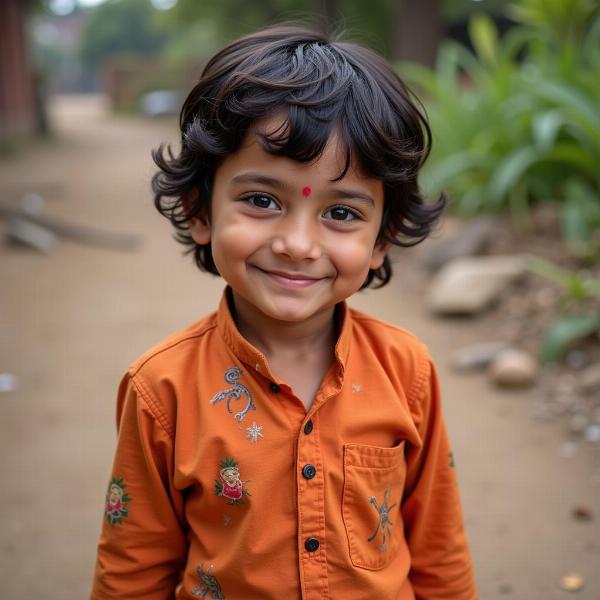Understanding the meaning of “boy” in Hindi can be more nuanced than a simple one-word translation. “Boy ka Hindi meaning” itself reveals the desire to delve deeper into the linguistic and cultural context. This guide will explore the various Hindi words for “boy,” examining their usage, cultural significance, and offering practical examples to solidify your understanding.
Decoding “Boy” in Hindi: लड़का (Ladka) and Beyond
The most common translation of “boy” in Hindi is लड़का (ladka). This word is generally used to refer to a male child or young man. However, depending on the context and regional variations, other terms might be more appropriate. Understanding these nuances is essential for accurate communication.
 A young Indian boy smiling
A young Indian boy smiling
For instance, बालक (balak) is another word for boy, often used in a more formal or literary context. It carries a connotation of innocence and youth. Think of ancient scriptures or epic poems where बालक (balak) is used to describe a young prince or hero. Similarly, छोकरा (chhokra) is a more colloquial term, frequently used in North India, especially in casual conversations.
Contextual Usage and Cultural Significance
The specific Hindi word you use for “boy” can significantly impact the meaning of your sentence. Using लड़का (ladka) when referring to a small child is perfectly acceptable, but using it for a grown man might sound odd. Similarly, using बालक (balak) in a casual conversation could come across as overly formal or even archaic.
Indian culture places a high value on respect for elders. Therefore, using respectful terms when addressing or referring to young men is crucial. Terms like युवक (yuvak) or नौजवान (naujawan) are appropriate when referring to older boys or young men. These terms not only denote age but also convey a sense of respect and acknowledgment of their transition into adulthood.
“Boy” in Different Scenarios: Examples
Let’s consider some practical examples:
- A young child playing in the park: “वह लड़का पार्क में खेल रहा है” (Wah ladka park mein khel raha hai) – “That boy is playing in the park.”
- Referring to a teenage boy: “वह छोकरा स्कूल जाता है” (Wah chhokra school jata hai) – “That boy goes to school.” (More colloquial)
- Speaking about a young man: “वह युवक बहुत मेहनती है” (Wah yuvak bahut mehnati hai) – “That young man is very hardworking.”
- In a literary context: “बालक ने शेर का सामना किया” (Balak ne sher ka samna kiya) – “The boy faced the lion.”
These examples demonstrate how the specific context dictates the most appropriate Hindi word for “boy.”
What are some other Hindi words related to “boy”?
- Beta (बेटा): Son
- Bhai (भाई): Brother
- Dost (दोस्त): Friend (male)
Conclusion: Choosing the Right Word
Understanding the subtle differences between the various Hindi words for “boy” is key to communicating effectively and showing cultural sensitivity. By carefully considering the age, context, and level of formality, you can ensure your language is both accurate and respectful. Remember, language is more than just words; it reflects culture, values, and relationships.
FAQ:
- What is the most common Hindi word for boy? The most common word is लड़का (ladka).
- What is a more formal word for boy in Hindi? बालक (balak) is considered more formal.
- What is a more colloquial term for boy in North India? छोकरा (chhokra) is frequently used in casual conversation.
- How do I refer to a young man respectfully in Hindi? युवक (yuvak) or नौजवान (naujawan) are appropriate terms.
- What does बेटा (beta) mean in Hindi? बेटा (beta) means son.
Looking for Professional Hindi Translation Services?
Meaning-Hindi.in offers expert Hindi translation services for various needs, from business documents and legal papers to website localization and educational materials. Our team of skilled linguists ensures accurate and culturally sensitive translations, bridging language barriers and fostering clear communication. Contact us today for a quote! Email: [email protected], Phone: +91 11-4502-7584. Meaning-Hindi.in is your trusted partner for all your Hindi translation needs.